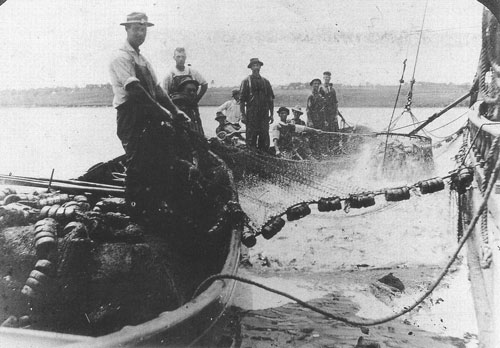B A C K T H E N

Turn of the century. Broad Bay, Waldoboro. Seining pogies during one of the occasional summers when the fish returned. The fishermen keep tension on the twine while the steam-powered dipnet bails fish. One would not wish to engage in a bear-hugging contest with a pogy fisherman—if his powerful arms didn’t leave you breathless, his powerful aroma surely would.
A standard pogy seine was 1,800 feet long by 150 feet deep. When the reddish “color” of a school had been spotted, two “drivers” rowed off in small boats to mark the direction of travel. The fishermen manned the two rowed seineboats, each having one-half of the seine flaked in its stern. When the boats reached the school, they encircled the fish as rugged “seine heavers” hove out the net. As soon as the circling boats met, bow to bow, heavy weights were run down the purse line to help close the trap. These were retrieved, and the men hauled in the purse line, then the cork line and twine. After the net was pursed, the steamer made fast to the bunt.
Everyday setbacks included elusive schools, tide-twisted twine, and twine torn, or “rim-racked,” by a sharp bottom. Mistakenly setting on a body of small blue-backed herring, which “mashed” (meshed) in the twine, was a nightmare. Cotton twine, like green hay, heated and had to be salted down after every use.
After the pogy bust, many Maine steamers went to southern New England; many Mainers followed. This steamer may hail from Mystic, Connecticut, but she likely has Mainers in her crew. Every spring a moraine of dunnage belonging to Down Easters accumulated at the Providence depot. About 1900 the twine trust threw a bash at New York’s Astor House for pogy skippers fishing between Maine and Chincoteague; the guest list included such Lincoln County names as Murray, Leeman, Tarr, Thompson, Laughton, Curtis, Mason, and Prior. The Priors and the Masons, of Round Pond, had originally come from Rhode Island.
Text by William H. Bunting from A Days Work, Part 2, A Sampler of Historic Maine Photographs, 1860 - 1920, Part II. Published by Tilbury House Publishers, Gardiner, Maine. 800-582-1899
